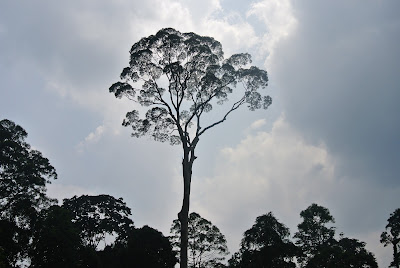 |
| Patronas Towers, Kuala Lumpur |
Malaysia’s image as an Asian economic tiger is not without foundation. Since the 1970’s, its monetary base has been steadily growing, bolstered by an abundance of natural resources, best encapsulated by the construction of the opulent Petronas Towers, the crowning jewels of cosmopolitan Kuala Lumpur. Along with Petronas oil, the sky-rising capital’s wealth has been reaped from timber and the ‘miracle’ fruit of the palm oil tree (Elaeis guineensis).
East of this economic Eden lie the western states of Malaysia, those of Sarawak and Sabah on the equatorial island of Borneo. These states make up the majority of Malaysia’s territories, and prove the most important in filling the nation’s coffers. A casual visit to Sabah seems to suggest that the state’s infrastructure has benefited from the fruits of the forest, in both tourism revenue and agro-timer expansion. The city of Kota Kinabalu is polished, with waterfront bars and mega-malls flogging global fashions, whilst the tourist lodges at Sepilok (with its famous orangutan rehabilitation centre) Kinabatangan, Tabin, and in the Danum Valley are of a standard able to cope with the demands of the British Royal Family. At the household level too, access to healthcare, education and economic development have flourished since the 1970s, when the state kicked off its enterprise in agro-timber expansion.
 |
| Primary Rainforest of Danum Valley |
50 % of the state of Sabah continues to be covered in forests, although most has been logged, and in the case of certain sites, repeatedly. Natural timber outside of the protected areas of forest in Sabah (which now cover about 20 % of the territory) is almost completely exploited, and in the eyes of the industrial agro-business lobby, would prove far more lucrative were it to be converted to palm oil plantations (which cover a further 20 % of the state’s land mass). The role of oil palm in rainforest destruction is now well documented, and numerous attempts have been made to redress the situation. Indeed the Roundtable on Sustainable Palm Oil is a group of industries and NGOs which have set in place laws which enshrine the protection of primary forest against further expansion of oil palm. In Sabah however, given that almost all primary forest is now protected in the form of nature reserves, it is the secondary forest (already exploited) which is under threat. And it is now increasingly apparent that these secondary forests can prove critical to the survival of the forests within protected areas.
 |
| Oil Palm at the Eden Project |
Disturbed areas of forest have been shown to support larger numbers of threatened mammals such as elephant and orangutan, due to the greater abundance of fruiting trees which are quick to grow in the gaps left by the logged timber trees. But it is the continuous forest cover provided by these secondary forests which is most important, acting as a bridge between the protected area islands. Such cover allows for the survival of species which require large areas of forest if they are to reproduce. Looking around a lowland forest in Borneo, 90 % of the large trees you see are members of the Dipterocarpaceae family, thus a group of high importance within the forest. But once a forest’s size has been reduced to below 200 Ha, the production of seeds and the survival of their seedlings is severely limited. Another organism which required large tracts of forest to survive is the Bornean Rhino (Dicerorhinus sumatrensis harrissoni), which roams over huge areas and remains alone until meeting to breed. A forest which can house enough males and females to maintain a genetically viable population must therefore be expansive. In the latest survey of rhino populations here, the state of play in Borneo’s forests was made jarringly clear. The females caught had multiple tumours in their reproductive tracts, thought to occur when mating is not frequent enough, and ultimately preventing any further successful reproduction. In April 2015, this species was declared extinct within the state of Sabah.
 |
| A lone Koompassia excelsa tree in logged secondary forest |
The extinction of the rhino is a clear signal that Sabah’s rainforests are under threat if a business-as-usual approach is to be taken to oil palm cultivation in years to come. The current legislation put forward labeling oil palm as sustainable is not enough to protect the crucial secondary forest, and given that current oil palm plantations now face severe soil degradation as a result of their repeated harvesting, the dilemma facing Sabah is how to continue to sustain the economic and social benefits gained from the years of its expansion. Palm oil is not an inherent evil as is so often over simplified, but its role in past and future management of tropical forests must be addressed.





